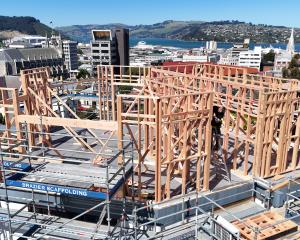
The wind of last Thursday wrecked havoc throughout the south, knocking over trees of all shapes and sizes.
Some large Elm trees, which were planted for the 1925 South Seas Exhibition, were blown over in Anzac Ave, while shelter belts were knocked over and large trees in parks and reserves were flattened.
University of Otago associate professor in botany Janice Lord said it was something of a surprise to see how shallow the roots of the Elm trees in Anzac Ave were.
"It really depends on the soil, so if the soil’s fairly compacted the roots will go where the water is," Associate Prof Lord said.
"If the soil’s compacted, you might end up with a very shallow root plate. But some types of trees have shallower roots than others. It is a hard thing to study. There’s actually not a lot known about root systems, because you need a tree to fall over before you actually see it."
She said the roots went where the nutrients were, so the trees had risen through the soil where the grass was, which made them insecure.
There were not many nutrients under the pavement or the road.
"A lot of the trees that fell over were quite top-heavy — quite tall trees with a big canopy were much more likely to fall over," Prof Lord said.
She said branches were pruned at the bottom of many trees and they became very vulnerable as all the weight was at the top.
Many people pruned trees this way for shade but it exposed them to winds.
"A lot of the street trees we plant are big, spreading, European-type of trees with a lot of canopy up above but no branches down below, because people and cars have to go down below. It does make them much more vulnerable."
She said poplars used for shelter belts were notorious for snapping off.
With the shelterbelts, it was like dominoes stacked beside each other.
"Trees in windy places will grow in a way that protects them against the prevailing wind. But if the wind comes from a different direction that can catch them and knock them over despite them being quite well adapted to wind."
"You know, a well-grown huge tree is a magnificent thing. And, I love trees. But you look at some of these really big heritage trees and you think, if that goes over, it could do so much damage.
"So it’s a fine balancing act, it really is. But I would hate to live in a city where there’s no trees. That would be really sad."
Replacing trees could be a chance to plant a more appropriate set of diverse and native trees.
Certain types of trees such as elms, oaks and London plane were preferred as they were fast-growing and could tolerate compaction and pollution.
"It would just be sad for people to overreact and not plant trees. But it’s just a matter of, you know, right tree, right place."












